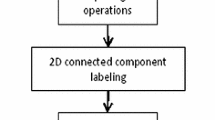Abstract
The objective of this study is to propose and validate a computer-aided segmentation system which performs the automated segmentation of injured kidney in the presence of contusion, peri-, intra-, sub-capsular hematoma, laceration, active extravasation and urine leak due to abdominal trauma. In the present study, total multi-phase CT scans of thirty-seven cases were used; seventeen of them for the development of the method and twenty of them for the validation of the method. The proposed algorithm contains three steps: determination of the kidney mask using Circular Hough Transform, segmentation of the renal parenchyma of the kidney applying the symmetry property to the histogram, and estimation of the kidney volume. The results of the proposed method were compared using various metrics. The kidney quantification led to 92.3 ± 4.2% Dice coefficient, 92.8 ± 7.4%/92.3 ± 5.1% precision/sensitivity, 1.4 ± 0.6 mm/2.0 ± 1.0 mm average surface distance/root-mean-squared error for intact and 87.3 ± 8.4% Dice coefficient, 84.3 ± 13.8%/92.2 ± 3.8% precision/sensitivity and 2.4 ± 2.2 mm/4.0 ± 4.2 mm average surface distance/root-mean-squared error for injured kidneys. The segmentation of the injured kidney was satisfactorily performed in all cases. This method may lead to the automated detection of renal lesions due to abdominal trauma and estimate the intraperitoneal blood amount, which is vital for trauma patients.






Similar content being viewed by others
References
Nishijima, D. K., Simel, D. L., Wisner, D. H. et al., Does this adult patient have a blunt intra-abdominal injury. JAMA 307:1517–1527, 2012.
Linguraru, M. G., Pura, J. A., Chowdhury, A. S. et al., Multi-Organ Segmentation from Multi-Phase Abdominal CT via 4D Graphs using Enhancement, Shape, and Location Optimization. Med. Image Comput. Assist. Interv. 13:89–96, 2010.
Linguraru, M. G., Pura, J. A., Pamulapati, V. et al., Statistical4D graphs for multi-organ abdominal segmentation from multiphase CT. Med. Image Anal. 16:904–914, 2012.
Li, C., Wang, X., Li, J. et al., Joint probabilistic model of shape and intensity for multiple abdominal organ segmentation from volumetric CT images. IEEE J. Biomed. Health Inf. 17:92–102, 2013.
Wolz, R., Chu, C., Misawa, K. et al., Automated abdominal multi-organ segmentation with subject-specific atlas generation. IEEE Trans. Med. Imaging 32:1723–1730, 2013.
Badakhshannoory, H., and Saeedi, P., A model-based validation scheme for organ segmentation in CT scan volumes. IEEE Trans. Biomed. Eng. 58:2681–2693, 2011.
Chen, X., Summers, R. M., Cho, M. et al., An automatic method for renal cortex segmentation on CT images: evaluation on kidney donors. Acad. Radiol. 19(5):562–570, 2012.
Muto, N. S., Kamishima, T., Harris, A. A. et al., Renal cortical volume measured using automatic contouring software for computed tomography and its relationship with BMI, age, and renal function. Eur. J. Radiol. 78:151–156, 2011.
Torimoto, I., Takebayashi, S., Sekikawa, Z. et al., Renal Perfusional Cortex Volume for Arterial Input Function Measured by Semiautomatic Segmentation Technique Using MDCT Angiographic Data with 0.5-mm Collimation. Am. J. Roentgenol. 204(1):98–104, 2015.
Li, S., Jiang, H., Yao, Y., and Yang, B., Organ Location Determination and Contour Sparse Representation for Multiorgan Segmentation. IEEE J. Biomed. Health Inf. 22:852–861, 2018.
Gibson, E., Giganti, F., Hu, Y. et al., Automatic Multi-Organ Segmentation on Abdominal CT with Dense V-Networks. IEEE Trans. Med. Imaging 37:1822–1834, 2018. https://doi.org/10.1109/TMI.2018.2806309.
Khalifa F, Soliman A, Elmaghraby A, Gimel’farb G, El-Baz A (2017) 3D Kidney Segmentation from Abdominal Images Using Spatial-Appearance Models. Comput. Math Methods Med. https://doi.org/10.1155/2017/9818506.
Davis, M. L., Stitzel, J. D., and Gayzik, F. S., Thoracoabdominal organ volumes for small women. Traffic Injury Prevent. 16:611–617, 2015.
Rezai, P., Tochetto, S., Galizia, M. et al., Perinephric hematoma: semi-automated quantification of volume on MDCT: a feasibility study. Abdom. Imaging 36:222–227, 2011.
Kanki, A., Ito, K., Tamada, T. et al., Dynamic Contrast-Enhanced CT of Abdomen to Predict Clinical Prognosis in Patients with Hypovolemic Shock. Am. J. Roentgenol. 197:980–984, 2011.
Kiw-Yong, K., Young Joon, L., Soon Chul, P. et al., A Comparative Study of Methods of Estimating Kidney Length in Kidney Transplantation Donors. Nephrol. Dial. Transplant. 22:2322–2327, 2007.
Illingworth, J., and Kittler, J., The Adaptive Hough Transform. IEEE Trans. Pattern Anal. Mach. Intell. 9:690–698, 1987.
Mao, S. S., Ahmadi, N., Shah, B. et al., Normal Thoracic Aorta Diameter on Cardia Computed Tomography in Healthy Asymptomatic Adults: Impact of Age and Gender. Acad. Radiol. 15:827–834, 2008.
Farzaneh, N., Reza Soroushmehr, S.M., Patel, H., et al. Automated Kidney Segmentation for Traumatic Injured Patients through Ensemble Learning and Active Contour Modeling. Conf. Proc. IEEE Eng. Med. Biol. Soc. 3418–3421, 2018.
Author information
Authors and Affiliations
Corresponding author
Ethics declarations
Conflict of Interest
The authors declare that they have no conflicts of interest. No funding was received for this study.
Ethical Approval
All procedures performed in studies involving human participants were in accordance with the ethical standards of the institutional and/or national research committee and with the 1964 Helsinki declaration and its later amendments or comparable ethical standards.
Informed Consent
Informed consent was obtained from all individual participants included in the study.
Additional information
Publisher’s Note
Springer Nature remains neutral with regard to jurisdictional claims in published maps and institutional affiliations.
This article is part of the Topical Collection on Image & Signal Processing
Rights and permissions
About this article
Cite this article
Tulum, G., Teomete, U., Cuce, F. et al. Automated segmentation of the injured kidney due to abdominal trauma. J Med Syst 44, 5 (2020). https://doi.org/10.1007/s10916-019-1476-1
Received:
Accepted:
Published:
DOI: https://doi.org/10.1007/s10916-019-1476-1




